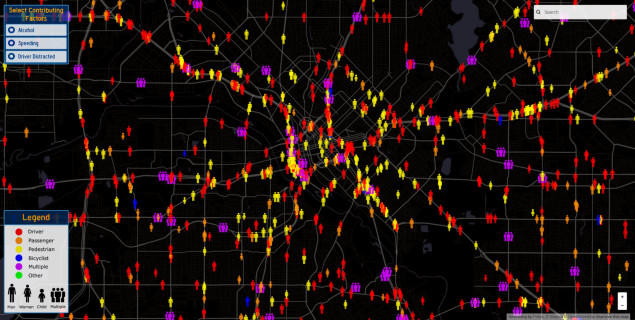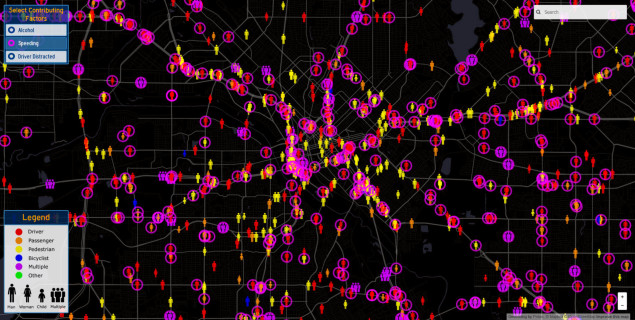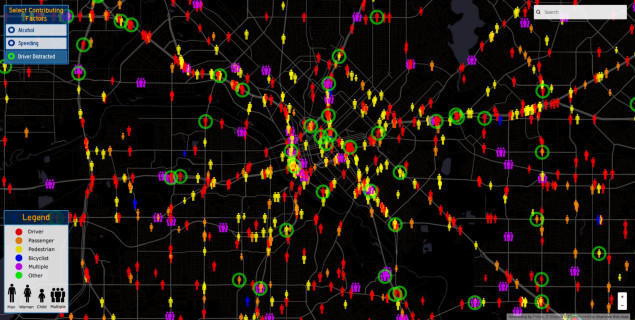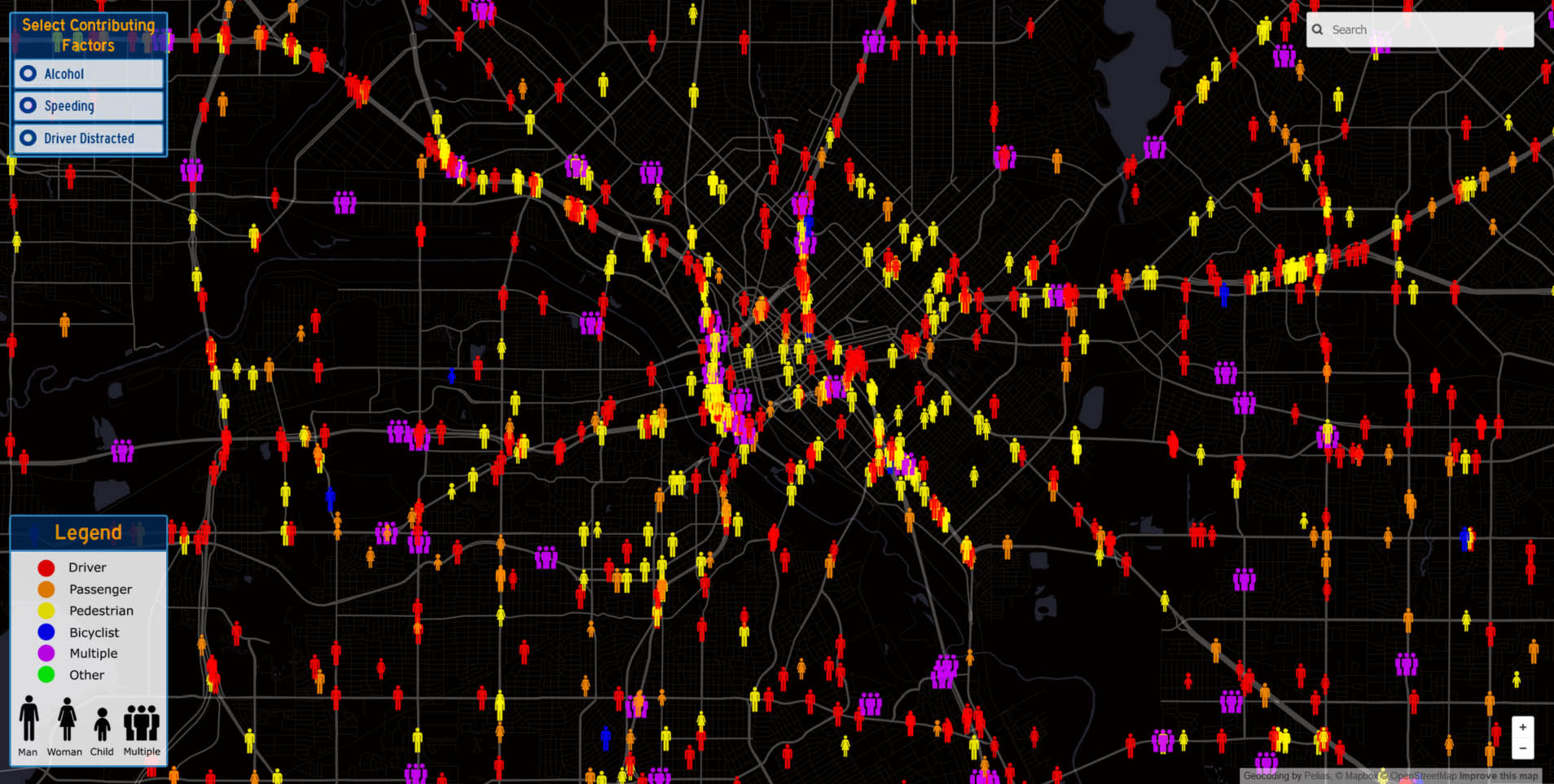The problem with #EndTheStreak, like most non-reforms is that it aims too low and isn’t about altering policy. The hashtag to end the streak of at least one Texan being killed on Texan roads every single day for the last billion days, is that it is impotent and no different from every other effort to reduce traffic fatalities which assigns blame without understanding the full context of a system that produces traffic fatalities.
In tone, the sentiment reads like much of the DMN’s Grow South coverage. We should all feel bad and when we do so everything will be alright. It’s like we’ve been transported to catholic school. While the emotional aspect is in the right place, the logical component for systemic reform is not.
At its core, it shunts responsibility from the public sector that funds and designs roads to a standard in the name of safety which actually leads to the opposite. “If we all just behave a little bit better” is the essence of the message when that very rhetoric is doomed to fail when the audience won’t listen. Why? We’re blaming the jackass when being the jackass is advantageous given the system.
The way we’ve designed our roads is for the least common denominator, the impossible attempt to reduce conflict between cars and cars and cars and people and cars and inanimate objects only serves to increase the severity of those conflicts, by turning our brains off and speeding up the cars. It’s like trying to have the most technologically advanced football helmet only to have bigger, faster dudes slamming into each other at full speed. The brain still sloshes around in its vessel.
By turning off the higher levels of our brain, which need to stay active by daydreaming or distracting ourselves in other ways, makes us automatons as drivers, relying only on the lowest order of simple brain activity. Green light go, red light stop. It turns off our empathy. Other cars aren’t people. They’re the enemy. This is where road rage comes from.
Asking drivers to slow down is like asking Wall Street to stop making money out of goodness in their heart without changing parameters of system in which the actors can operate. It’s addressing the nature, but not the nurture.
The person that rolls through the stop sign, the person that accelerates through the yellow light, the person that speeds down any scale of street, etc. They’re all degrading the safety and overall attractiveness of the environment (as in surroundings), however each of these has a reward, albeit minor in the grand scheme of ‘racing to a red light’ sort of thing, that many people are at least subconsciously weighing these pros vs the cons of a warning or a fine, particularly at a time when police resources are better utilized elsewhere when street and network design can solve the majority of the issues.
We are all cut from the same genetic cloth and in groups, like an entire city trying to get around, will behave predictably dependent upon contextual factors. The system. When it comes to transportation, it is precisely those contextual factors that determine the safety or lackthereof of our roads.
Otherwise, there would be similar traffic fatalities everywhere. But that isn’t the case. And it has been proven that road fatalities can be reduced dramatically. This is where #VisionZero comes in and should be the banner we’re all waving rather than merely hoping to #EndTheStreak for but a day.
Vision Zero is actual policy that has been adopted by cities around the world and even entire countries. It’s about systematically reducing annual traffic fatalities to zero utilizing measurable metrics to determine the efficacy of policies that must adhere and strive to this goal. If fatalities don’t drop, try something new. If public safety is the foundation for governance and public policy, it is a dereliction of duty of our elected leaders to not pursue #VisionZero.
Oh, and here’s a new map of traffic fatalities in Dallas over a ten year span between 2004-13. It’s neatly organized by cause of death: alcohol, speeding, or distraction.

When we control for just speeding (the purple circles), it looks like the vast majority of driver/passenger deaths occurred due to speeding. What’s revealing here is that most of the yellow chalk outlines (pedestrians) weren’t killed by speeding. That’s because the chance of death for pedestrians jumps to 50% if hit at 30 mph or higher. This is why responsible cities like London are instituting 20 is plenty plans where all city streets have 20 mph design speed. DESIGN speed is critically different than SIGNED speed. Design speed means the geometries and features of the road are designed in a way to slow drivers down and encourage calm, safe traffic. I’ll get to what that means in a second.

Below in white circles are deaths where drinking occurred. Naturally, there is quite a bit of overlap between drinking and speeding. What’s truly tragic is that the speeding deaths mostly occur on the fastest roads, the highways. Where driving is intended to be fast, people drive even faster.

Below is distracted driving deaths encircled in green. What is striking here is just how few there are proportionally to all of the deaths shown on the map. Yet, distracted driving seems to be TxDOT’s largest campaign. Should all of their marketing effort go towards where they have the least impact? Perhaps if they just followed their own ITE/CNU manual for context sensitive design, all of their resources would go towards safety measures by designing safer transportation systems — which of course would mean no highways.

What is more important to pay attention to (or not) are the DMN’s suggestions for ##EndingTheStreak. They don’t get at the root problem and are essentially the same ineffectual efforts that have been around forever yet have had little meaningful impact beyond the improvement of actual car design.
– Buckle seatbelt: All passengers need to be buckled
– Never drink and drive: Drunk driving kills; get a sober ride home.
– Pay attention: Put your phone away and avoid distractions.
– Drive the speed limit: Always follow speed limits and drive slower speeds when weather or conditions warrant.
Let’s take these one by one and then I’ll get to the design factors that actually determine traffic speeds. Buckle your seatbelt. Yes, do this. It’s the law. Duh. But your buckled belt won’t help the poor pedestrian you just ran over when applying your makeup or shaving as you drive into work because you didn’t have time to do it at home because your driving commute is an hour because of traffic because we’ve sufficiently induced car travel demand so that there are few other realistic ways to get around. Congrats, NCTCOG.
“Never drink and drive.” Of course. This is also the law. However, let’s think about this for a second. Where do the most drinking and driving deaths occur? That’s right, car dependent places. Further, we have minimum parking standards for bars. By law, we’re in effect mandating drinking and driving.
Pay Attention. As I said earlier, the way we have designed our roads turns off our brains. We’re practically begging people to distract themselves in any possible way. In transit friendly cities you can read, do work, play around on your phone no problem.
Drive the speed limit. Gag me. Drivers drive as fast as they feel comfortable. This is where we need to spend some time and understand where speed limits come from.
Speed limits are set by the 85th percentile rule, which is the speed at which 85% will drive and feel comfortable. Therefore, 15% are comfortable speeding (problem 1). Further, road standards (the geometries) of a road are set by the hierarchical order, which is set by the Thoroughfare Plan, which all cities must have. The Thoroughfare Plan then determines what roads are eligible for state and federal funding.
Because cities love them so free money, they’re incentivized to raise the level of roads to higher orders in the hierarchy to get more money. Once those roads are a higher order, say bumping a local street to a collector or a collector to an arterial, or an arterial to a highway (or all of the above over a long enough time line!), the higher order then triggers new standards which means bigger roads, wider lanes, more gentle curves, all of which make for faster driving.
Once 85% start driving the faster speed they feel comfortable, the speed limit is raised to a point where people start dying and then locals ask, “maybe this is too fast.” Then they lower the speed limit and then more people speed because they still feel comfortable driving at the previous speed which the road was designed for. It’s a vicious cycle indeed.
Instead, here are the real reasons for speeding, dangerous driving, and severe conflict points that cause traffic fatalities and the ways we can redesign our roads to 1) encourage safer driving 2) encourage more economic development and 3) more active modes of transportation.
1 – Environment – The most speeding occurs on rural roads (as do highest incidence of per capita traffic fatalities) where you have to drive everywhere due to proximity and there is little to distract you or reason to slow down. Low conflict, low stress, increased comfort, increased distance between things, increased speed. However, we’ve introduced the same road designs into our cities, which is a terrible idea where conflicts are invariably going to be higher due to increased economic activity (until anti-city roads completely kill a city and all of its economic activity of course). This is why NACTO has responded with different design standards for cities than the more ruralized AASHTO standards.
2 – Mode/Distance – This is a fact: the faster we design roads, the more land uses spread apart. The further apart things are, the more we must drive. More driving, more chance of traffic fatalities. You’re not going to find a traffic fatality in Venice. This is also why we’re going to end up with driverless cars: human error. We’re not evolved to have the proper reaction speed above 20 or so mph. Plus, we also like to drink alcohol and set minimum parking laws for bars.
3 – Parking Requirements – Minimum parking standards also separate everything apart, disconnect the urban fabric, discourage walkability, and mandate driving. Who is going to walk through all of this? If all of those uses, the office, the hotel, the retail, and the residential were clustered together people could walk between those uses if they so chose.
4 – Lane Widths – Many roads are designed to highway standards with travel lanes over 12′. It’s been proven that narrower travel lanes reduce speed.
5 – Road Width and Amount of Travel Lanes – In my own research locally on Cedar Springs road, the fastest part of the road is actually not where there are six lanes but only four. However, normally you might say, well doesn’t that contradict what you’re saying? Not really, because all of these factors have to be taken into context. Where Cedar Springs is fastest, where I measured the average car speed to be high 40 mph those four travel lanes are 16′ wide each. In other words, bullet 4 can trump 5. However, a 6-lane road will almost always be faster than a 2-lane road.
6 – Geometry – That section of Cedar Springs Road also has a gentle curve to it. Sharp kinks in roads force us to slow down. However, conventional traffic engineering thinks those are dangerous because they assume we’re all dummies and would plow right into all of the pedestrians at 60 mph if there are any sharp, medieval kinks in the road. Of course, we are only driving 60 mph where the road allows and sharp turns don’t allow us to drive fast. Any time you have a curvy road through a city with curve radii over 300′ or so, you’re going to have some speeding issues.
7 – Intersection Density – Speeding also occurs where there are long stretches between intersections, because why go slow? Tight, gridded street networks have less incidence of speeding and less traffic fatalities. Intersections are conflict points, but they are controlled conflict points. They are also the atom, the very basic building block of any city as cities form at intersections of transportation networks. Intersections by creating convergence points are economic multipliers and reduce congestion because they diffuse traffic. Vibrant core cities have the highest intersection densities. Areas that degrade tend to have very low intersection density and thus poor accessibility.
8 – Friction, Both Visual and Physical – Visual friction is all of the things along the side of the road that might catch our eye, pedestrians, street trees, bikes, parked cars, retail stores lining the street, etc. These don’t actually distract us in the real world, but focus drivers. They tend to pay more attention because it isn’t in their best interest to hit one of these things. Yet, conventional traffic engineering, operating out of fear, actively seeks to reduce these potential conflict points and ‘fixed hazardous objects’ and thus, we drive faster and more dangerously. Congrats!
Physical friction can be the material the road is made out of, bricks or cobbles – whether comprising the entirety of the road or just an intersection or crosswalk, will provide a light rumble that slows traffic. Since these things tend to be expensive, I like to utilize them only where conflict points are potentially high like shared left turn lanes, crosswalks, intersections, etc.
Proper design is based in the real world. Unfortunately, most roads are designed in abstract and not for people. The people we’re trying to move around safely without being killed. If we were to happen to #EndTheStreak with one day without a traffic fatality, then what? Back to another streak? No, instead let’s focus on real policy changes at local, regional, and state level that seek to truly increase safety rather than the ImaginationLand coming out of Arlington.





